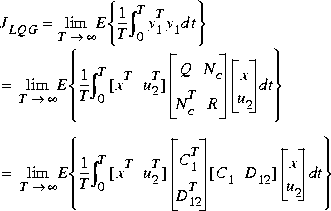

| Robust Control Toolbox |   |
H2 optimal control synthesis (continuous and discrete).
Syntax
[acp,bcp,ccp,dcp,acl,bcl,ccl,dcl] = (d)h2lqg(A,B1,B2,,D22) [acp,bcp,ccp,dcp,acl,bcl,ccl,dcl] = (d)h2lqg(A,B1,B2,,D22,aretype) [sscp,sscl] = (d)h2lqg(TSS) [sscp,sscl] = (d)h2lqg(TSS,aretype)
Description
h2lqg solves H2 optimal control problem; i.e., find a stabilizing positive-feedback controller for an "augmented" system

such that the H2-norm of the closed-loop transfer function matrix  is minimized:
is minimized:

The stabilizing feedback law F(s) and the closed-loop transfer function  are returned
are returned as
as
Figure 1-6: H2 Control Synthesis.
The optional inputaretype determines the method used by ARE solver aresolv. It can be either "eigen" (default), or "Schur".
dh2lqg solves the discrete counterpart of the problem by directly forming two discrete ARE's and solve them via daresolv. Note that in contrast to the H case, the bilinear transform technique does not apply in the H2 case. This is because the H2 norm, unlike the H
case, the bilinear transform technique does not apply in the H2 case. This is because the H2 norm, unlike the H norm, is not invariant under bilinear transformation.
norm, is not invariant under bilinear transformation.
Examples
See the Tutorial chapter for design examples and demonstrations. Especially, see the comparison between H2 synthesis and H synthesis in the Fighter H2 and H
synthesis in the Fighter H2 and H Design Example in the Tutorial section.
Design Example in the Tutorial section.
Algorithm
H2lqg solves the H2-norm optimal control problem by observing that it is equivalent to a conventional Linear-Quadratic Gaussian optimal control problem involving cost

with correlated white plant noise  and white measurement noise
and white measurement noise  entering the system via the channel [B1 D21]T and having joint correlation function
entering the system via the channel [B1 D21]T and having joint correlation function

The H2 optimal controller F(s) is thus realizable in the usual LQG manner as a full-state feedback Kc and a Kalman filter with residual gain matrix Kf.

 =
=  Tand satisfies ARE
Tand satisfies ARE 


The final positive-feedback H2 optimal controller  has a familiar closed-form
has a familiar closed-form
It can be easily shown that by letting  the H2-optimal LQG problem is essentially equivalent to LQ full-state feedback loop transfer recovery (see
the H2-optimal LQG problem is essentially equivalent to LQ full-state feedback loop transfer recovery (see ltru). Dually, as  you obtain Kalman filter loop transfer recovery [1] (see
you obtain Kalman filter loop transfer recovery [1] (see ltry).
 must both have full column rank.
must both have full column rank.
References
[1] J. Doyle and G. Stein, "Multivariable Feedback Design: Concepts for a Classical/Modern Synthesis," IEEE Trans. on Automat. Contr., AC-26, pp. 4-16, 1981.
[2] J. Doyle, Advances in Multivariable Control. Lecture Notes at ONR/Honeywell Workshop. Minneapolis, MN, Oct. 8-10, 1984.
[3] M. G. Safonov, A. J. Laub, and G. Hartmann, "Feedback Properties of Multivariable Systems: The Role and Use of Return Difference Matrix," IEEE Trans. of Automat. Contr., AC-26, pp. 47-65, 1981.
[4] G. Stein and M. Athans, "The LQG/LTR Procedure for Multivariable Feedback Control Design," IEEE Trans. on Automat. Contr., AC-32, pp. 105-114, 1987.
 | graft | hinf, dhinf, linf |  |